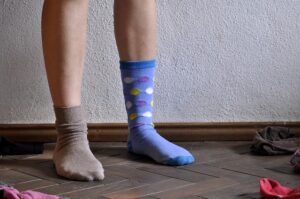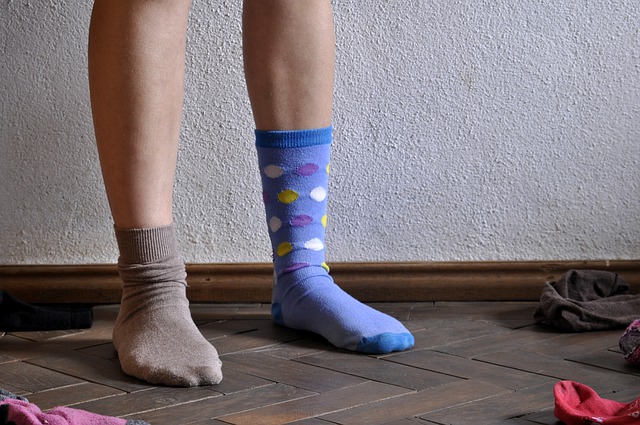Socks
 Let’s talk about socks.
Let’s talk about socks.
I don’t think I’ve ever written about socks. That’s because I have never ever had a problem with socks. I have the great privilege of being one of those runners for who ‘socks are socks’.
When I first started running, I ran in regular old cotton gym socks for years. I only started wearing running socks because someone gave them too me. But since those early years I have come to appreciate the value of good socks.
Like everything else in our sport, your sock choices and needs are going to be specific to you. Here, I’ll go through all the different choices and the ‘whys’ behind them.
First, why are socks important? Why do you care?
Nothing says you have to wear socks in the first place. Why are you wearing socks? What is their purpose? The main purpose of wearing socks is really comfort.
We all know people who run sockless in their shoes. I choose not to do this because I find it uncomfortable. I find the socks do serve a purpose.
- They keep the sharp edges of the shoes from rubbing and giving me blisters.
- They keep othodics and inserts from sticking to your feet and moving around.
- And, finally they keep your sweaty foot from getting all gross and stanky in your shoe and slipping around.
Now you may fins that running sockless is comfortable and that’s fine, go ahead. I don’t like it.
Now that we have decided we’re going to wear socks, what do we want from them?
The wrong socks can give you foot problems. Especially in longer races or in challenging weather.
The biggest among these is blisters. Blisters or their precursor hot-spots are caused by repeated rubbing. If you have socks that rub, or fit poorly, they can cause the blisters. For instance if the sock is too big, or the wrong shape, they can bunch up in the shoe and cause a blister.
Blisters from socks are going to be related to the fit, the material and the thickness. If you have issues with blisters, maybe a new sock can help.
A good sock will fit snugly to your foot, not bunch up and not slide around.
A good sock will wick moisture away from your foot and keep the foot relatively dry.
There are secondary issues that running socks try to solve.
First is cushioning. Many running socks will have extra or different material on the heel pad, the forefoot pad or around the toes. This is an attempt to help protect those areas from impact.
If you’ve got sensitive feet or problems in these areas you may try these socks with the padding or extra material. The pro is that it could be more comfortable to you. The con is that extra material can bunch up more and actually create the problems they are trying to solve.
My experience has been that if you have good running form and the right shoes, the padding is unnecessary and can cause blisters in longer runs. I do appreciate a thicker piece of material where the toe meets the shoe because, based on my foot and toes, this is where I tear through normal socks.
Second is support. Many of the high-tech running socks have panels sewn into them to support an area of the foot, like the arch. This is sort of like taping your foot for support. Again, if you have some symptoms that you think this might help with, try them out. Some socks extend all the way up to wrap the calves. These are more like calve sleeves with footies than socks.
Personally, I don’t see a need to conflate calf sleeves and socks. I have both. I do like a snug fitting sock that ‘holds’ my foot.
Third is hygiene. There are modern materials that are engineered with anti-microbial properties. The theory here is that socks made with this material will keep you from getting stinky feet. I have no opinion on the efficacy of this.
I have not experimented with these materials. I have found that a good technical sock wicks the sweat away from the foot into the shoe and it’s my shoes that get stanky, not my socks.
Fourth is temperature control. There are thicker socks made out of warmer material for winter running and there are thinner socks made out of cooling materials for summer running. You can judge for yourself if you need that.
Personally, I have never had the need special warm socks or special cool socks. If you’re running your body regulates heat pretty well and my feet never get cold.
A key thing to consider is fit and size. At the low end there are ‘no-show’ socks that end right at the edge of your shoe. Next up is ankle socks that stick above the shoe lip by a couple centimeters. Then there are calf socks and crew socks that cover parts of the calves.
The reason I mention this is that I have found that some of the no-show socks will creep down into my shoe as I’m running. Then I have to stop and pull them out. Which is a pain.
What I have found to be especially important is the fit. A snug fit protects the foot, supports the foot and doesn’t slide or creep.
I got a bunch of tech socks from Asics for the New York City Marathon and they were a fantastic example of this. These socks were thin and snug, contoured to the foot so they don’t slide around and offered good support and protection. The synthetic material was tough. It took me 3-4 years to tear through them.
I recently bought a cheaper athletic sock pack from Saucony and while they are fine, they creep down into my shoes because the fit and the material is not snug and I tore through them in 3 months.
Obviously it all comes down to how much you want to spend to get what you’re looking for. You get what you pay for. At least make sure they are technical material.
I’ve found socks to be a bit like shoes when it comes to brand loyalty – once people find a sock they like they become rabid fans of those socks and won’t run in anything else.
There are other variants on socks, but I’m going to leave it there.
In summary: This is another one of those things, like shoes, that can become a religious war so don’t get too wrapped up in your opinions. If you’ve got issues, try out different socks in your training and see if they help. I would start with a good, snug, thin, technical fabric sock designed for running and progress from there.

